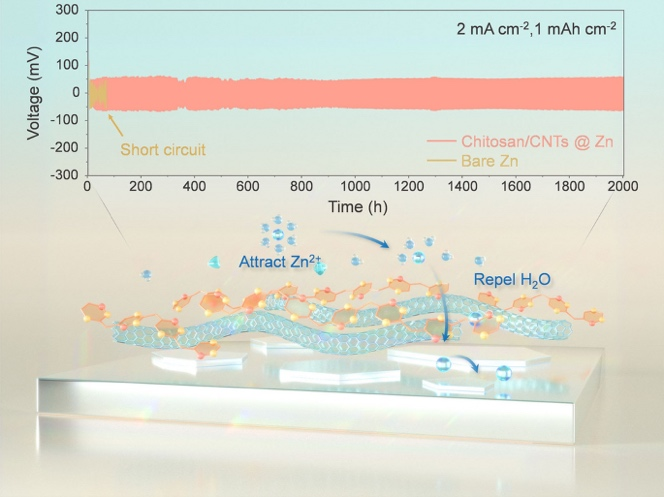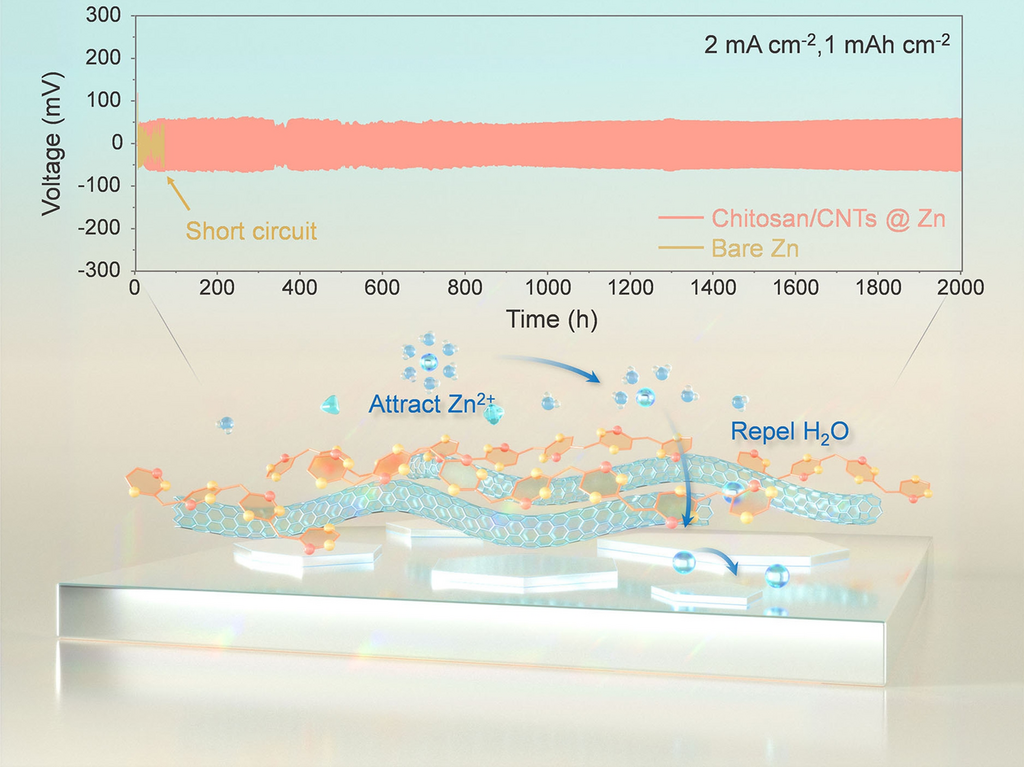Scalable and Sustainable Chitosan/Carbon Nanotubes Composite Protective Layer for Dendrite‑Free and Long‑Cycling Aqueous Zinc‑Metal Batteries

Aqueous zinc-ion batteries are celebrated as a green, low-cost alternative for grid storage—if only their anodes would stop growing deadly dendrites. Now, a multi-institutional team led by Prof. Hang Wei (Inner Mongolia University), Prof. Yuanyuan Zhang (IMU) and Prof. Jian Liu (University of Surrey) has borrowed a page from plant cell walls and developed a chitosan/carbon-nanotube (CNT) composite skin that turns ordinary zinc foil into an ultra-stable, dendrite-free and fully recyclable anode—all through a simple scraping process.
Why This Skin Works
-
Chitosan – the green glue
Protonated amino and hydroxyl groups act as Lewis-base “Velcro”, capturing Zn2+while repelling H2O and corrosive anions. The biopolymer dissolves in mild acetic acid, eliminating toxic PVDF binders and enabling closed-loop CNT recovery at end-of-life. -
CNTs – the conductive mesh
An entangled 3-D network equalizes the electric field, slashes local current density and lowers nucleation overpotential from 83 mV to 20 mV, guiding uniform zinc deposition instead of dendritic spikes. -
Scraping – the scalable step
A doctor-blade coats a 16 µm-thick film on zinc foil at room temperature; no vacuum, no electro-spinning, no energy burn.
Electrochemical Wins
Symmetric cells fitted with the chitosan/CNT skin survive more than 3 000 hours of zinc plating/stripping at 1 mA cm-2, while bare Zn shorts in under two days. Even at an aggressive 5 mA cm-2 or a deep-discharge depth of 85.6 %, the protected anode keeps cycling for hundreds of hours where bare metal quickly fails. The skin also pushes Zn//Cu coulombic efficiency to > 99 % over 500 cycles and trims the energy barrier for Zn2+ desolvation from 27.6 kJ mol-1 to 21.5 kJ mol-1, enabling faster, smoother deposition. In situ CT, Raman and finite-element modelling confirm dendrite-free, smooth plating under realistic current densities.
From Coin to Pouch to Robot
Paired with a commercial V2O5 cathode, the protected anode lifts full-cell capacity to 389 mAh g-1 and pushes energy density above 80 Wh kg-1 while cutting cell-level cost. A soft-pack prototype effortlessly powers a small robot, and the same skin stabilizes Al-ion symmetric cells, hinting at universal metal-anode protection.
Circular Economy Bonus
After cycling, the coating is peeled off, dissolved in glacial acetic acid and centrifuged—> 95 % of CNTs are reclaimed with zero morphology change (TEM verified). Recycled CNTs re-assemble into a fresh layer that still delivers > 500 h of stable cycling, proving true sustainability rather than a buzzword.
Bottom Line
By merging a $10 kg-1 biopolymer with recyclable CNTs through an ambient, binder-free scraping technique, the team offers the field a scalable, low-cost and earth-friendly route to dendrite-free zinc batteries. Expect this chitosan/CNT armor to accelerate the commercial arrival of safe, long-life aqueous storage systems—and to inspire similar bio-recyclable protections for next-gen Mg, Ca and Al metal anodes.
Stay tuned for more green-energy innovations from the IMU–Surrey–Swansea collaboration!
Follow the Topic
-
Nano-Micro Letters

Nano-Micro Letters is a peer-reviewed, international, interdisciplinary and open-access journal that focus on science, experiments, engineering, technologies and applications of nano- or microscale structure and system in physics, chemistry, biology, material science, and pharmacy.






Please sign in or register for FREE
If you are a registered user on Research Communities by Springer Nature, please sign in